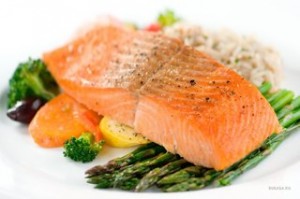You do not need to spoil your appetite with the thought of swallowing cod liver oil, but see yourself enjoy a piece of salmon instead. Dr. Jehangir N Din and collegues published an article entitled “Omega 3 fatty acids and cardiovascular disease—fishing for a natural treatment” in the first January edition of the British Medical Journal (BMJ 2004;328:30-35,January 3, 2004). These cardiology researchers from the University of Edinburgh/England have reviewed all of the recent medical literature regarding the beneficial effects of omega-3-fatty acids on heart disease. The following are some facts they found.
The interesting story regarding the omega-3-fatty acids, which have anti-inflammatory qualities, is that they balance the detrimental effects of the omega-6-fatty acids, which lead to inflammation not only in joints, but also in blood vessels. In the standard North American and European foods the omega-6-fatty acids are overconsumed. To counter the bad effects of the omega-6-fatty acids, more omega-3-fatty acids need to be ingested.
So, what should we consume in terms of omega-3-fatty acids? The American Heart Association made the recommendations in the second table below.
Current consumption of omega-3-fatty acids in North America and Europe is low. Recently an expert US panel of nutritionists determined that the US consumption per day is about 0.1 to 0.2 grams per day and should be 0.65 grams per day as a minimum according to the recommendations by the American Heart Association.
| Facts regarding omega-3-fatty acids: |
| Omega-3-fatty acids from fish and fish oils protect against heart disease |
| Following heart attacks fish oil is helpful in preventing more heart attacks |
| Hardening of arteries stops when fish oil or fish is eaten regularly |
| Rapid response critics pointed out that exercise is as important as fish oil |
| Trials with fish oil showed reduction in death rates from strokes and heart attacks from between 15% and 29% over 2 to 3.5 years (several studies) |
| The beneficial effects are due to a combination of stabilizing irregular heart beats, preventing clots, countering hardening of arteries, countering inflammation, improving function of lining of arteries, lowering of triglycerides (bad fatty acids) and lowering of blood pressure |
The authors of this paper from England disagree and state that at least 1 gram per day would be needed to lower the heart attack risk to the low levels in Asia. The British Nutrition Foundation has recommended to use 1.2 grams of omega-3-fatty acids per day.
| Fish or fish oil capsules as a protective effect on blood vessels* |
| Patients without documented coronary heart disease: Eat a variety of (preferably oily) fish at least twice weekly. Include oils and foods rich in inolenic acid |
| Patients with documented coronary heart disease: Consume 1 g of eicosapentanoic and docosahexanoic acid daily, preferably from oily fish. Supplements could be considered in consultation with a doctor |
| Patients with hypertriglyceridemia: Take 2-4 g of eicosapentanoic acid and docosahexanoic acid daily, provided as capsules under a doctor’s care |
| *As recommended by American Heart Association |
How does that translate into how much fish you would have to eat to get about 1 gram of omega-3-fatty acids per day? To make things simpler I have categorized fish and seafood in the table below based on the data from this article into low, medium and high marine derived omega-3-acid foods. You obviously need to eat more of the low category seafood to achieve 1 gram of omega-3-fatty acid than of the high category seafood.
| How much fish and seafood you need to eat to get 1 gram of omega-3-fatty acids… | |
| Concentration of omega-3-fatty acids in seafood: | Type of fish and seafood consumed: |
| Low (eat 1 lbs) | Catfish, Haddock |
| Medium (eat 1/3 -1/2 lbs) | Tuna, Halibut, Oyster, Cod, Flounder, Sole |
| High (eat 2 or 3oz.) | Atlantic salmon, Sardines, Rainbow trout, Atlantic herring, Mackerel |
Before you overindulge in seafood from the low and medium category, check with your doctor first whether you are allowed so much protein. Some people have protein restrictions due to poor kidney function or because of gout. The authors of this study stated that you should eat a seafood meal with 1 gram of omega-3-fatty acid twice per week. Other sources of omega-3-fatty acids (=alpha-linolenic acid) are plant products such as soy beans,flaxseed, walnuts and rapeseed oil. In Asia fish and soy bean products are consumed in much bigger quantities than in the US.
Last edited December 8, 2012






